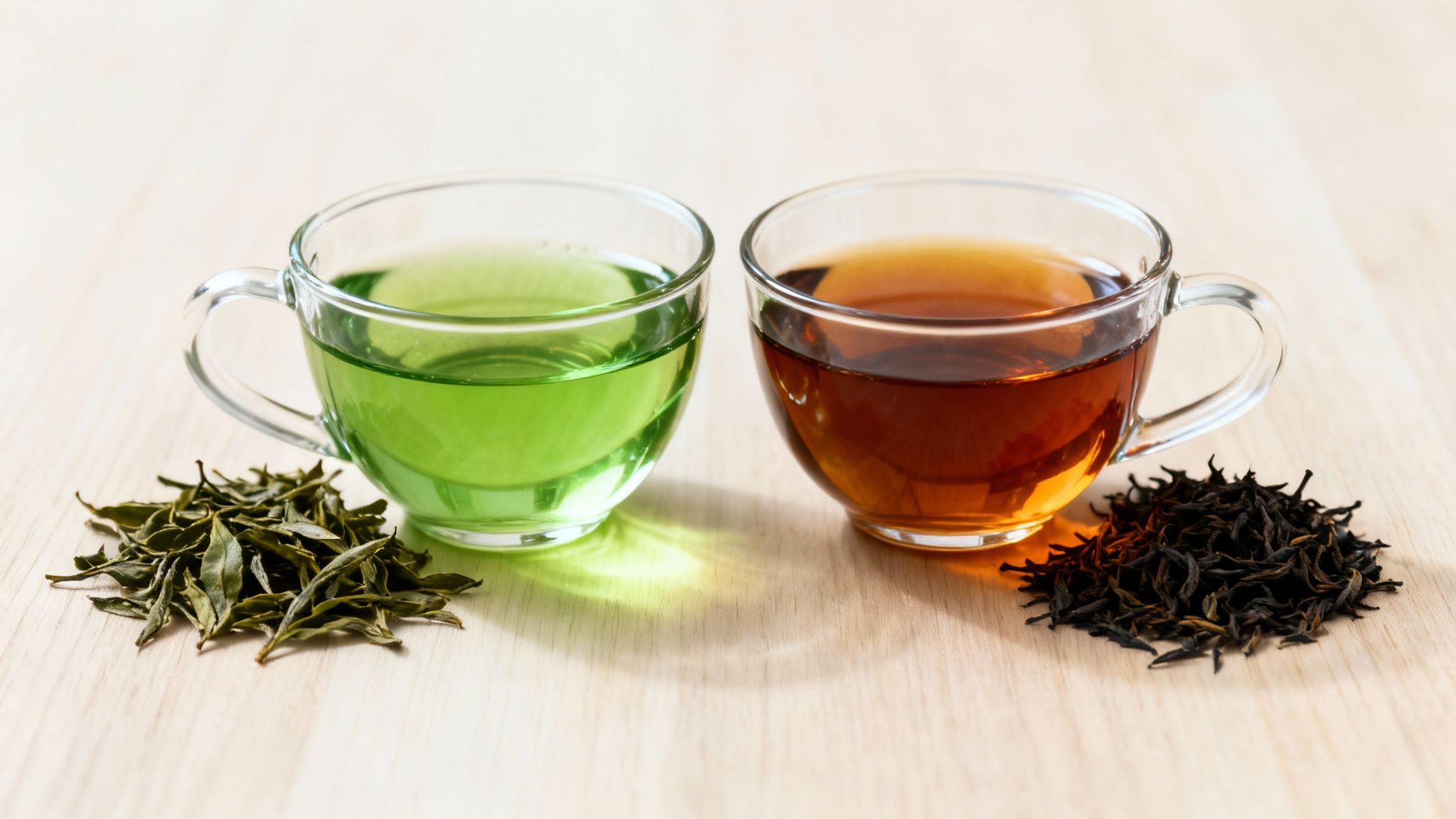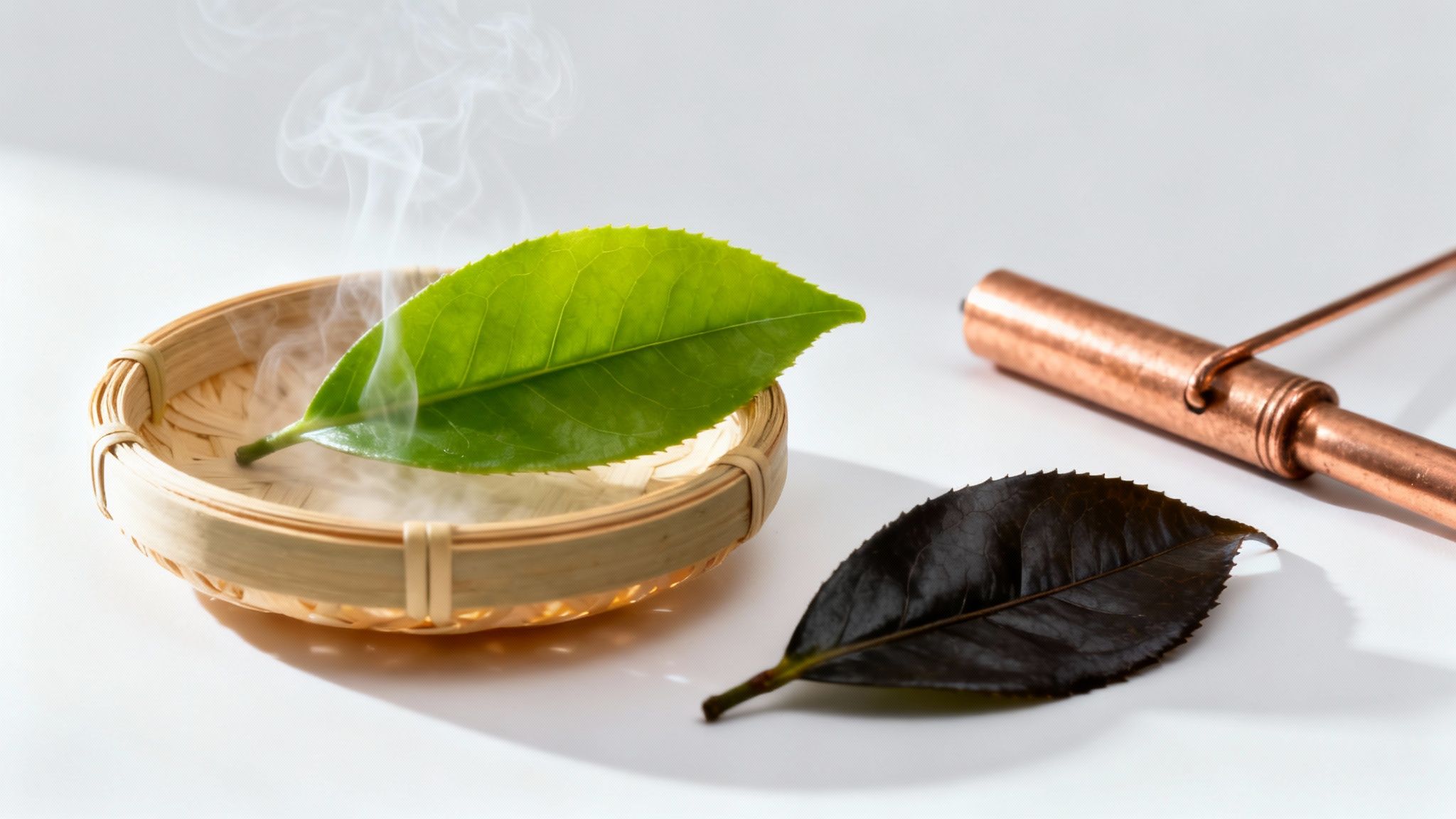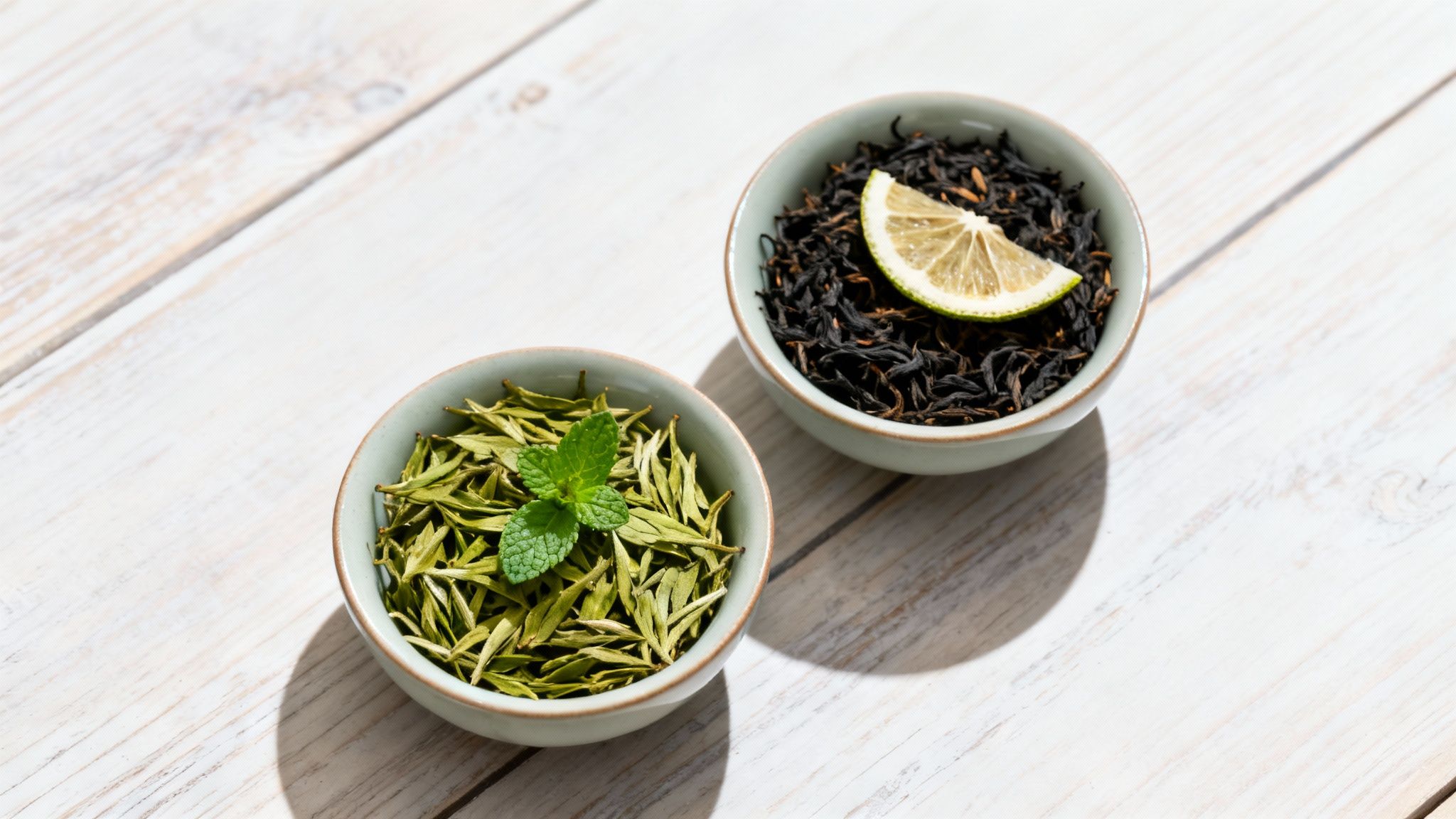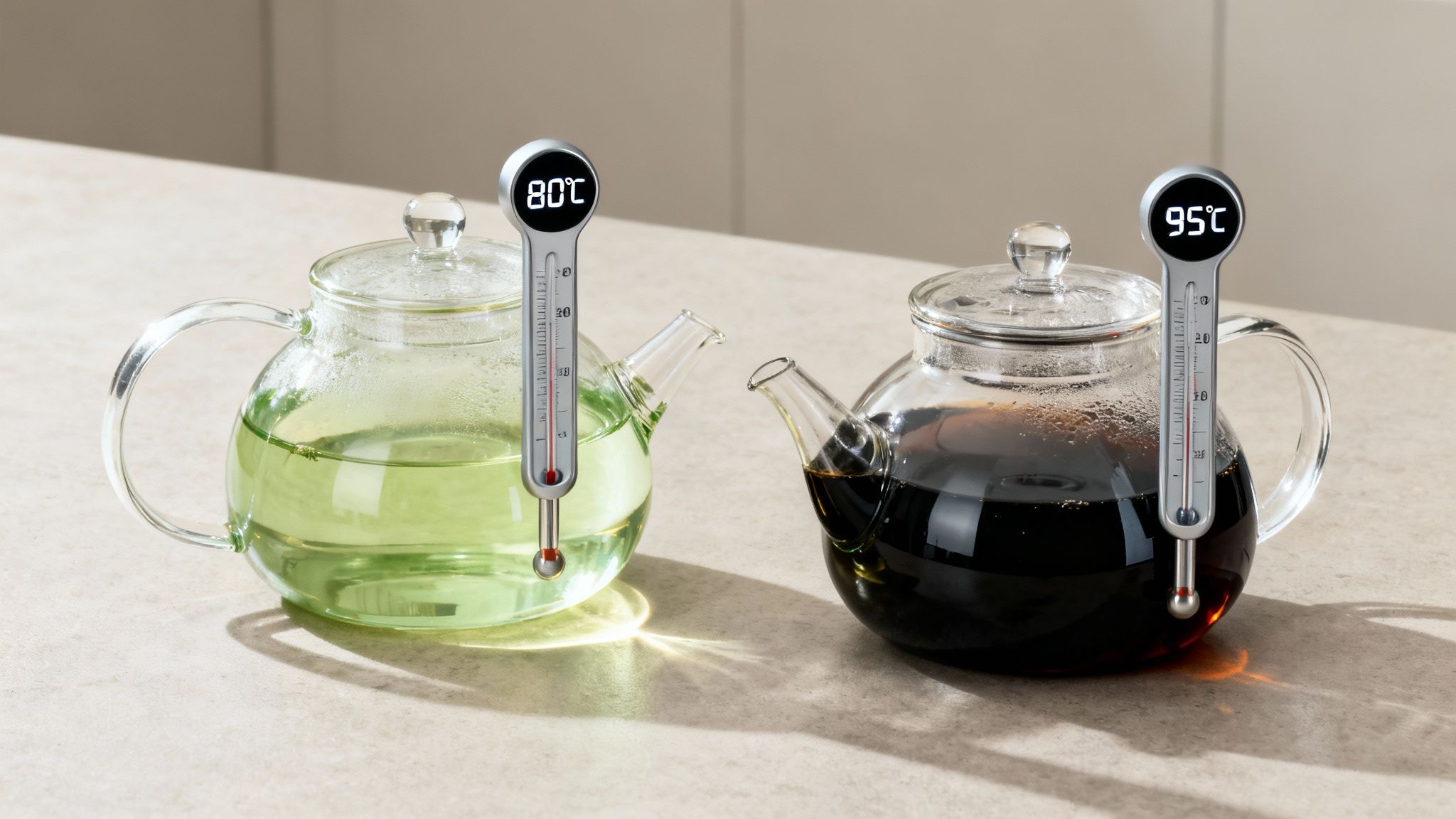When you get right down to it, the main difference between green and black tea all comes down to one thing: oxidation. Black tea is fully oxidised, which gives it that robust, dark flavour we know and love. Green tea, on the other hand, is left unoxidised, preserving its fresh, delicate taste. It's this single step in processing that creates two completely different drinks from the very same plant.
Understanding The Tea Fundamentals

It’s a fact that surprises many people: both green and black tea come from the exact same plant species, Camellia sinensis. The incredible variations you see and taste—their appearance, flavour, and even their health benefits—aren’t down to different plants. It’s all about what happens to the leaves after they’ve been picked. The journey from a fresh leaf to your teacup is where the real magic happens.
This guide will walk you through all the details, helping you appreciate the nuances that make each tea unique. We’ll explore everything from how they’re made to their cultural significance here in the UK. Once you understand the key distinctions, you can make a much more informed choice for your daily cuppa.
But first, let's start with a quick look at the main differences at a glance.
Core Differences at a Glance
This table gives you a high-level summary of what sets green and black tea apart, so you can get an immediate feel for their distinct characters before we dive deeper.
| Characteristic | Green Tea | Black Tea |
|---|---|---|
| Processing | Unoxidised (steamed or pan-fired to prevent oxidation) | Fully oxidised (leaves are withered, rolled, and oxidised) |
| Flavour Profile | Grassy, vegetal, nutty, sweet, sometimes oceanic | Malty, robust, full-bodied, sometimes fruity or smoky |
| Colour | Pale green to light yellow | Deep amber to reddish-brown |
| Caffeine Level | Lower (typically 20-45 mg per cup) | Higher (typically 40-70 mg per cup) |
| Main Antioxidants | Catechins (especially EGCG) | Theaflavins and Thearubigins |
| Cultural Role in UK | Growing in popularity, seen as a wellness choice | The traditional, quintessential 'cuppa,' often with milk |
This table shows just how much that one processing step influences everything else, from flavour to chemistry.
The critical factor is oxidation—the chemical reaction that occurs when the enzymes in the tea leaves are exposed to oxygen. Halting this process early creates green tea; allowing it to complete its course results in black tea.
While these two are the most famous, there are many other fascinating types of tea out there to discover, each with its own unique production method and flavour profile. Understanding this foundational difference between green and black tea is the perfect starting point for exploring the wider, wonderful world of tea.
How Processing Defines Each Tea

The journey from a fresh leaf on the Camellia sinensis bush to the brew in your cup is a tale of two very different paths. The biggest difference between green and black tea isn’t the plant itself, but one critical step in its preparation: oxidation. This single process dictates everything from the tea's colour and flavour to its chemical makeup.
Think of oxidation like slicing an apple and leaving it on the counter; it starts to brown as soon as it's exposed to the air. Tea leaves do the same thing. The decision to either stop or encourage this process is what creates the great divide between green and black tea.
Green Tea: The Preservation Process
To create green tea, the mission is simple: prevent oxidation at all costs. Almost immediately after being picked, the leaves are quickly heated to stop the enzymes responsible for browning from doing their work. It's this crucial heating step that locks in the leaf's natural green colour and its fresh, vibrant character.
Tea makers generally use one of two methods, and each gives the tea a completely different personality:
- Steaming: This is the go-to method in Japan for teas like Sencha. The leaves get a quick blast of steam, which results in that brilliant green colour and a flavour that’s often described as oceanic, vegetal, or even a bit like seaweed.
- Pan-firing: In China, this is the classic technique for teas like Dragon Well. The leaves are tossed around in a large, hot wok, which gives them a toastier, nuttier, and slightly sweeter profile.
By stopping oxidation in its tracks, green tea hangs on to a high concentration of natural compounds called catechins. These are what give green tea its famous health properties and that distinct, sometimes sharp, astringent taste.
Black Tea: The Transformation Process
Black tea, on the other hand, is all about encouraging full oxidation. This complete transformation is what changes the leaves' chemistry, creating the deep colours and bold flavours we know and love in blends like English Breakfast or Assam.
The process for black tea is a bit more involved. First, the leaves are withered to reduce their moisture, making them soft and pliable. Then, they are rolled or bruised, which breaks down the cell walls inside the leaves and lets the enzymes get to work with the oxygen, kicking off the oxidation.
The leaves are then left to oxidise in a controlled, humid environment. This stage can last for several hours, and it’s where the magic happens. The leaves turn from green to a deep coppery-brown as those catechins convert into more complex compounds called theaflavins and thearubigins.
Finally, the leaves are dried with hot air to stop the oxidation completely. This locks in the rich, malty, and often fruity notes. This carefully controlled transformation is why the green vs black tea debate is really a conversation about chemistry and craftsmanship.
A Guide to Tea Flavour Profiles

While the science of processing sets the stage, it's in the flavour where the real magic of tea comes alive. If you look past the simple descriptions, you’ll discover a whole world of sensory details that will help you find your perfect cup.
Green tea is often dismissed as just being ‘grassy’, but that really doesn't do it justice. The truth is, its character is incredibly varied, shaped profoundly by where it grew and how it was handled.
The Spectrum of Green Tea Flavours
Tasting a green tea can feel like a journey, taking you from a misty Chinese mountainside to the Japanese coast with a single sip. The way the leaves are heated to stop oxidation has a huge say in the final flavour you get.
Two main styles really stand out:
- Japanese Greens: These teas are typically steamed, which locks in a vibrant, almost electric green colour. This method brings out those oceanic, marine notes—what we often call umami or savoury. A classic Sencha, for example, has a wonderfully distinct vegetal and slightly briny character.
- Chinese Greens: Often pan-fired in enormous woks, these teas develop a much softer, toastier profile. A brilliant example is Dragon Well (Longjing), which is loved for its smooth, mellow body and sweet, nutty notes that bring roasted chestnuts to mind.
The sheer variety within green tea means there’s almost certainly a flavour out there for everyone. It’s a journey of discovery that rewards the adventurous.
If you're keen to explore this diversity, figuring out what makes for the best green tea is a fantastic place to start. And the unique profiles don't just stay in the cup; the scent of matcha is so well-loved it even inspires other products, like this lovely Matcha Green Tea candle.
The Bold World of Black Tea Flavours
Black tea offers a completely different, but just as complex, experience. Allowing the leaves to fully oxidise creates that deep, robust character with its signature malty backbone. But just like green tea, its origin story makes all the difference.
Just think about the different personalities of these iconic black teas:
- Assam: Coming from India, Assam is the quintessential strong, full-bodied black tea. Its powerful malty flavour and brisk, bold finish can easily stand up to milk and sugar, which is why it’s a cornerstone of so many breakfast blends.
- Darjeeling: Also from India but grown high in the Himalayas, Darjeeling is a world away in terms of delicacy. It’s famous for its complex floral and fruity notes, often described as having a ‘muscatel’ grape quality that’s earned it the nickname "the champagne of teas."
- Earl Grey: Now this isn't a regional tea, but a flavoured one. A black tea base, often from China or Sri Lanka, is infused with the oil of bergamot orange. This is what gives it that signature citrusy, floral aroma and bright, uplifting taste we all know and love.
Caffeine and Antioxidants: What's the Real Difference?
When it comes to green vs black tea, most people get hung up on the caffeine. But honestly, the more interesting story is in their unique antioxidant profiles. While the caffeine kick does vary, it’s the specific compounds in each tea—shaped entirely by oxidation—that offer distinct benefits.
It's a common myth that black tea is always the high-caffeine option. Yes, on average, a cup of black tea packs between 40-70 mg of caffeine, while green tea sits a bit lower at 20-45 mg. But that's not the whole picture. The type of leaf, how long you brew it, and even the water temperature can flip those numbers on their head. A punchy, well-brewed green tea can easily out-caffeinate a weak black tea.
A Tale of Two Antioxidants
The true divergence between green and black tea lies in their chemical makeup. Green tea is famous for its high concentration of catechins, especially one called epigallocatechin gallate (EGCG). This is the powerhouse compound often linked to supporting metabolic health and protecting cells.
When black tea is made, the oxidation process transforms these very catechins into something new: theaflavins and thearubigins. These are the compounds that give black tea its deep, dark colour and brisk flavour. Research points to them as being particularly good for cardiovascular health and promoting a happy gut.
So, it’s not about which tea is 'healthier'—it’s about which one’s unique benefits fit what you’re looking for. Do you want something to support your metabolism, or is heart health more of a priority?
This is the key. You’re not choosing a 'better' tea, you're choosing between two different, but equally valuable, sets of protective compounds.
Picking Your Brew for the Moment
Your choice can change from one day to the next, depending on what your body needs.
- A gentle afternoon lift? Go for green tea. Its lower caffeine and dose of L-theanine deliver a calm, focused energy that’s perfect for avoiding those late-afternoon jitters.
- A proper morning start? Black tea is your friend. It gives you that robust caffeine kick to get going, along with compounds that support long-term heart health.
Here in the UK, while a classic black cuppa is still king, green tea is catching up fast. The 2022 UK Tea Census found that while 74% of us drink black tea, a massive 55% also enjoy green tea. It shows we've really come to appreciate both. You can read the full report to find out more about UK tea consumption habits.
At the end of the day, both teas are a brilliant way to get more antioxidants into your system. If you're looking to boost your intake even further, you might also be interested in some of the top antioxidant supplements out there to complement your daily brew.
UK Tea Culture: Tradition vs Modern Trends
In the UK, the green vs black tea debate is more than just a question of flavour—it’s a window into the country's evolving cultural identity. For centuries, black tea has been the undisputed king, the very essence of a British 'cuppa'. It’s a symbol of comfort and daily ritual, almost always brewed strong with a generous splash of milk.
This isn't just a habit; it's woven deep into the national fabric. Think of a classic English Breakfast blend—that robust, malty brew was designed to get the nation going. This deep-rooted history has ensured black tea remains the dominant force on supermarket shelves and in kitchen cupboards across the country.
The Shifting Tastes of a Nation
But things are changing. While the traditional cuppa still holds its own, green tea is steadily making its mark, especially with younger and more health-aware drinkers. It has carved out a new space for itself, seen less as a simple brew and more as a mindful wellness choice.
This rise is fuelled by a growing curiosity about green tea's specific health benefits and an appreciation for its more delicate and varied flavour profiles. For many, it offers a fresh, modern alternative to the classic builders' brew.
The UK's tea scene is a fascinating place where heritage and modern wellness trends happily coexist. Black tea represents comforting tradition, while green tea embodies a conscious, contemporary lifestyle. Realising this helps explain why both have earned a firm place in British homes.
The market data paints a clear picture of this cultural tug-of-war. Black tea still makes up about 84% of all tea drunk in the UK, with its market segment valued at around £295 million back in 2020. Yet, green tea is the fastest-growing category, signalling a clear shift in what we're choosing to put in our mugs. You can find more fascinating figures in these tea industry statistics on steepedcontent.com.
Generational Tea Preferences in the UK
This evolving dynamic really comes to life when you look at generational habits. Younger tea drinkers are often more adventurous, keen to explore a world of tea far beyond the standard black tea bag their parents might have relied on.
The table below highlights how different age groups are approaching their daily brew, illustrating green tea's growing appeal.
Generational Tea Preferences in the UK
| Tea Type | Consumption by Age 25-34 | Consumption by Age 55+ |
|---|---|---|
| Standard Black Tea | 74% | 85% |
| Green Tea | 52% | 35% |
| Specialty Black Tea | 50% | 28% |
| Fruit/Herbal Tea | 51% | 40% |
The data shows a clear trend: while traditional black tea remains a staple for the over-55s, younger generations are eagerly embracing green, specialty, and herbal infusions.
Ultimately, the choice between green and black tea in the UK is becoming an increasingly personal one. It reflects a wonderful blend of tradition, health awareness, and individual taste in a nation that truly loves its tea.
Brewing the Perfect Cup Every Time

This is where the magic really happens. Mastering the brew is how you unlock the full spectrum of flavour from your chosen leaves, and it’s simpler than you might think. Small tweaks to water temperature and how long you steep the tea for are what separate a good cup from a truly great one.
Green tea is delicate. Its chemical structure is more fragile, so it needs a gentler approach. If you pour boiling water straight onto the leaves, you'll scorch them. This releases too many tannins, which is what gives you that bitter, astringent taste. The trick is to just let your kettle sit for a minute or two after it clicks off.
Green Tea Brewing Essentials
To get the absolute best from your green tea, a little precision goes a long way. A lower temperature and a shorter brew time are your best friends here, protecting all those subtle, complex notes.
- Water Temperature: Aim for around 75-80°C. It’s just the right temperature to coax out the flavour without any bitterness.
- Steeping Time: A quick infusion of 1-3 minutes is all it needs. I’d suggest starting at the lower end and tasting—you can always pop it back in if you want it stronger.
Black Tea Brewing Perfection
Black tea, on the other hand, is a much more robust character. It needs a bolder approach to draw out its deep, malty flavours and signature rich colour. Hotter water and a bit more time are essential for that satisfying, full-bodied cup.
- Water Temperature: Use water that’s just off the boil, right around 95°C.
- Steeping Time: Let it steep for a good 3-5 minutes. This gives it time to develop that wonderful strength and complexity.
The biggest mistake is treating all teas the same. Green tea requires finesse to preserve its fresh character, while black tea needs heat and time to reveal its rich depth.
This is something more and more people are discovering, especially as younger Brits get more adventurous with their daily cuppa. In fact, 37% of UK adults aged 25-34 now regularly drink five to six different types of tea. Over half of them enjoy green tea right alongside their traditional black brew. You can read more on these evolving tea preferences from Mintel's research.
Don't forget that your choice of teaware matters, too. A quality teapot holds its heat evenly, giving you a much more consistent infusion from start to finish. For a proper deep dive, check out our complete guide on how to brew loose leaf tea for more of our expert tips.
Got Questions? We've Got Answers
Diving into the world of tea can throw up a few practical questions, especially when you're weighing up two of the biggest players. We get it. Here are some straight answers to the things we're most often asked about green and black tea.
Can You Put Milk in Green Tea?
Look, we're not the tea police, but adding milk to green tea isn't something we'd usually recommend. The delicate, grassy, and sometimes nutty notes of a good green tea just get completely lost under the creaminess of milk. It creates a bit of a flavour clash.
Black tea, on the other hand, with its bold, malty backbone, is a perfect match for milk and sugar. If you're really after that creamy green tea fix, a matcha latte is what you're looking for – it’s specifically designed to work beautifully with milk.
Which Is Better for Weight Loss?
Green tea tends to grab the headlines here, mostly because it's packed with EGCG, a catechin that some studies suggest can give your metabolism a gentle nudge.
But let's be realistic. The real win is that both teas are practically calorie-free if you drink them without any extras. Swapping out sugary sodas or juices for a cup of tea – green or black – is the smarter move. Lasting weight loss comes down to your whole diet and lifestyle, not just the type of tea in your mug.
The biggest impact comes from replacing high-calorie drinks with unsweetened tea, whether that's green or black. It's a simple swap that really adds up over time.
Is It Okay to Drink Both Every Day?
Absolutely! Drinking both green and black tea daily is a brilliant way to enjoy their unique flavours and health perks. Why not kickstart your morning with a robust black tea for a proper energy lift, then ease into the afternoon with a gentler green tea for a bit of calm focus?
As long as you keep an eye on your total caffeine intake for the day, there's no reason not to make both a regular part of your routine.
At Jeeves & Jericho, we’re all about celebrating the unique character of every single leaf. Explore our curated collection of premium whole leaf teas to find the perfect brew for you. Discover the difference quality makes at https://www.jeevesandjericho.com.


